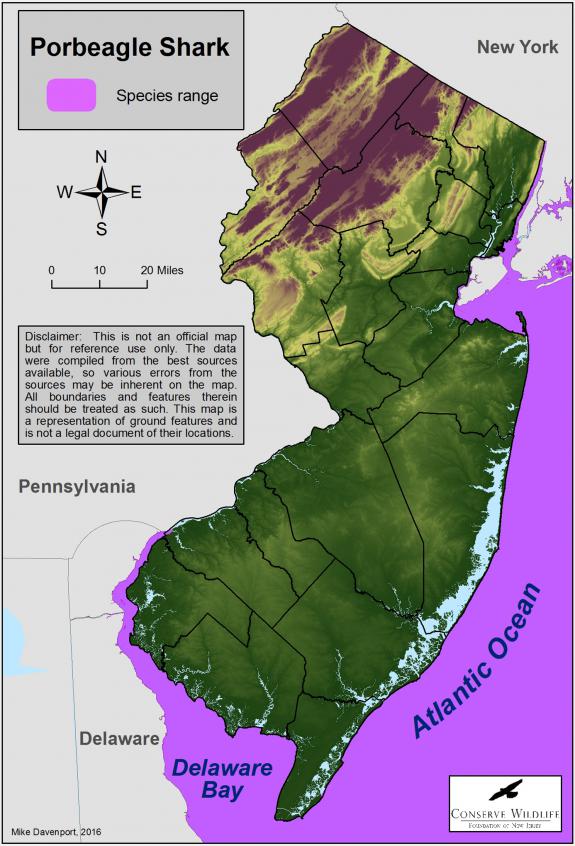Lamna nasus
Type: fish
Status: not ranked
Species Guide
Porbeagle shark
Lamna nasus
Species Type: fish
Conservation Status: not ranked
IDENTIFICATION
The porbeagle shark is a close relative of the white shark and mako shark. It is a large shark with a heavy spindle-shaped body. They are known to reach 11.6 feet in length and 300 pounds. Color is grey above with a white belly. The large first dorsal fin usually has a distinctive white free rear tip.
The snout is short and conical. It has long gill slits, strong keels on the caudal peduncle, and a crescent-shaped tail. They can be distinguished from white sharks by their spike-like smooth-edged teeth (which are better suited for catching fish) and by the position of the second dorsal fin, which is found directly over the anal fin.

Distribution & Habitat
The porbeagle shark occurs within cold and temperate waters of the North Atlantic and Southern Oceans. Within the northwest Atlantic, they can be found between Newfoundland in the north and southern New Jersey in the south.
This species can be found in both inshore and offshore waters. They migrate between inshore and surface waters during the summer and offshore deeper waters during the winter. They rarely enter shallow coastal waters. They can be found at depths of up to 1000 feet.
Diet
This species feeds on bony fish, smaller sharks, and squid. They are generally not considered to be dangerous to humans.
Life Cycle
Males of this species reach sexual maturity when they are approximately 5.5 feet in length and 8 years old while females reach sexual maturity at approximately 6.4 feet in length and 13 years old.
Porbeagles are ovoviviparous, giving birth to approximately four young each year which are between 33-39 inches when born. The gestation period is believed to be about 8-9 months.
The porbeagle is one of several shark species which are endothermic, possessing countercurrent heat exchangers within their circulatory system. This allows them to maintain a body temperature which is 13-18 degrees Fahrenheit above the temperature of the water around them. This allows them to hunt at greater speed and at greater depth as well as within waters which are too cold for other shark species.
Current Threats, Status, and Conservation
The porbeagle shark is classified by NOAA Fisheries as a Species of Concern within the northwest Atlantic Ocean and there are restrictions on commercial and recreational catches. It currently has no legal conservation status in New Jersey and may be caught and landed, with restrictions on catch size and number.
This species is often targeted as a game fish and its meat is highly valued. Since the start of commercial exploitation in the 1960’s, the northwest Atlantic population of this species has declined by about 90%. Reasons for the species decline include both commercial and recreational fisheries and as by-catch. Its slow growth and late maturity further hamper its recovery. There is also concern that reduction of some prey items (such as groundfish) due to overfishing, may adversely affect the porbeagle. Marine pollution, especially from plastics, also threatens this and many other marine species.
Although the species is slowly recovering, full recovery of the population is projected to take decades.
Text written by Michael J. Davenport in 2016.
References
- Compagno, Leonard, M. Dando and S. Fowler. 2005. Sharks of the World.
Scientific Classification
- Kingdom: Animalia
- Phylum: Chordata
- Class: Chondrichthyes
- Order: Lamniformes
- Family: Lamnidae
- Genus: Lamna
- Species: L. nasus